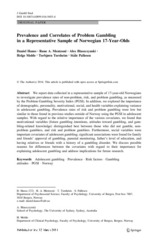Prevalence and Correlates of Problem Gambling in a Representative Sample of Norwegian 17-Year-Olds
Hanss, Daniel; Mentzoni, Rune Aune; Blaszczynski, Alex; Molde, Helge; Torsheim, Torbjørn; Pallesen, Ståle
Peer reviewed, Journal article
Published version
Permanent lenke
https://hdl.handle.net/1956/8983Utgivelsesdato
2014-03-12Metadata
Vis full innførselSamlinger
Originalversjon
https://doi.org/10.1007/s10899-014-9455-4Sammendrag
We report data collected in a representative sample of 17-year-old Norwegians to investigate prevalence rates of non-problem, risk, and problem gambling, as measured by the Problem Gambling Severity Index (PGSI). In addition, we explored the importance of demographic, personality, motivational, social, and health variables explaining variance in adolescent gambling. Prevalence rates of risk and problem gambling were low but similar to those found in previous studies outside of Norway using the PGSI in adolescent samples. With regard to the relative importance of the various covariates, we found that motivational variables (future gambling intentions, attitudes toward gambling, and gambling-related knowledge) distinguished best between those who did not gamble, non-problem gamblers, and risk and problem gamblers. Furthermore, social variables were important covariates of adolescent gambling; significant associations were found for family and friends’ approval of gambling, parental monitoring, father’s level of education, and having relatives or friends with a history of a gambling disorder. We discuss possible reasons for differences between the covariates with regard to their importance for explaining adolescent gambling and address implications for future research.

